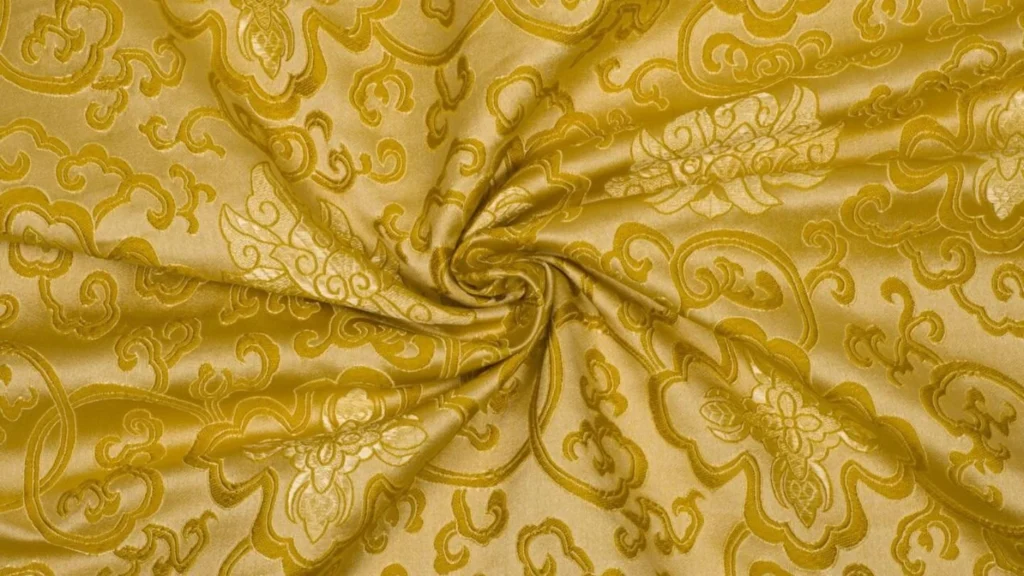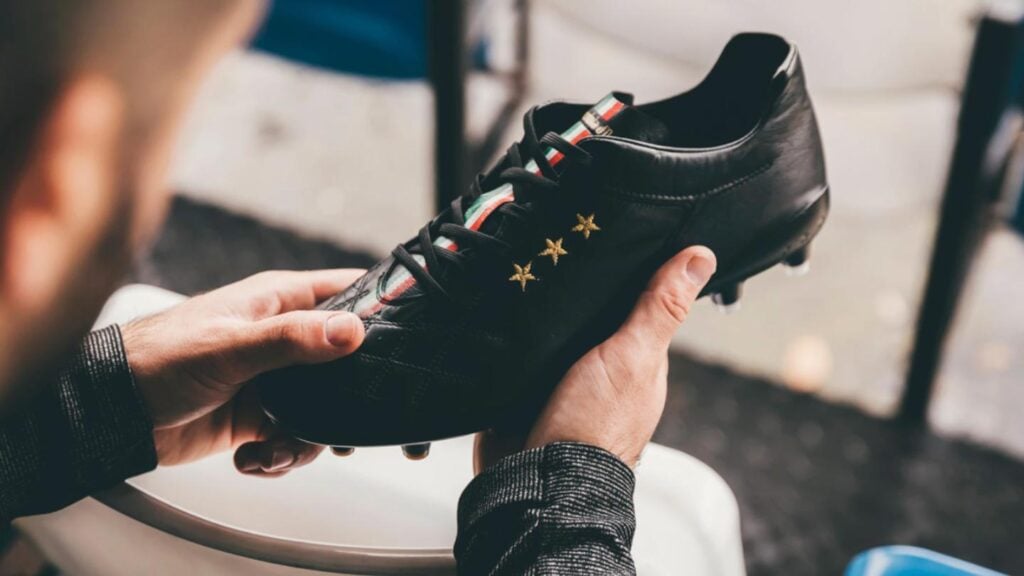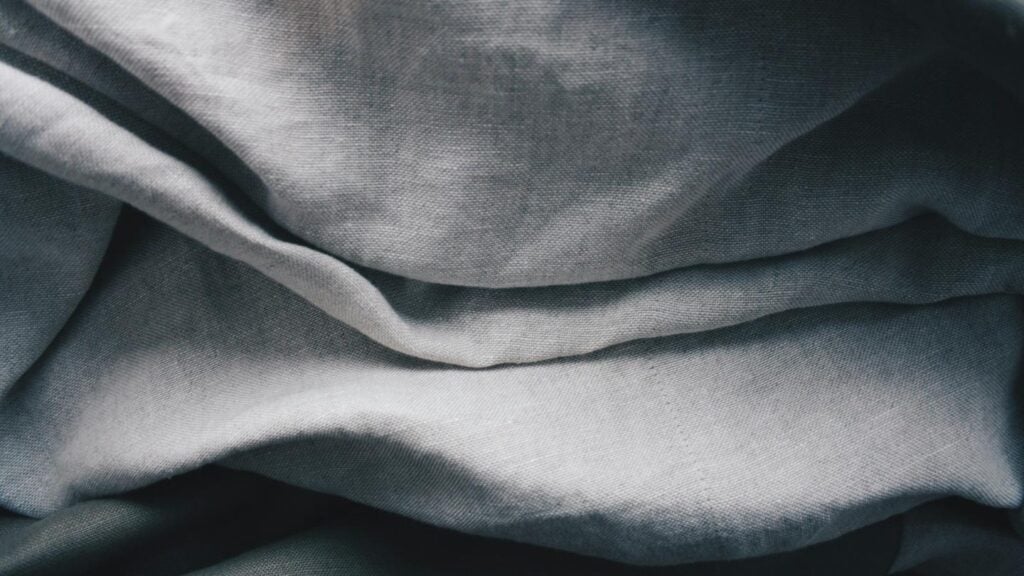2 – Corduroy Fabric Composition
3 – Corduroy Fabric vs Other Fabrics
4 – Corduroy Fabric Is Manufactured
5 – Common Uses in Fashion
6 – Understanding the Environmental Impact of Corduroy Fabric
7 – Exploring Price Points and Value for Money
8 – Conclusion
9 – FAQs
What is Corduroy Fabric?
Corduroy fabric is a distinctive, textured material characterized by its ridged surface, known as “Wales.” These ridges run parallel to each other, creating the fabric’s signature look and feel. Corduroy is typically made from cotton, though blends with polyester or other fibers are also common. Its durable nature and unique texture have made it a popular choice for clothing, home décor, and accessories.
- Origin:
The history of corduroy dates back to ancient Egypt, where a similar fabric was used to make garments. However, the fabric we recognize today as corduroy originated in England during the 18th century. It was originally called “corde du roi,” meaning “cloth of the king,” reflecting its luxurious status. Corduroy became widely used in Europe and the United States in the 19th century, particularly for workwear and casual clothing due to its durability. - Structure and Composition:
Corduroy is woven using a technique called “cut-pile,” where the fabric’s fibers are raised to create the ridged surface. These ridges are formed by weaving in extra fibers that are cut and brushed to stand up. The spacing of these ridges, known as the “wale,” can vary from fine, narrow Wales to wide, chunky ones. The number of Wales per inch determines the fabric’s feel and weight—finer Wales are lighter and softer, while wider Wales are heavier and more textured. - Properties:
Corduroy fabric is known for its versatility. It is warm, making it a great choice for colder weather, while still being breathable due to its cotton composition. It’s soft to the touch, yet durable enough to withstand regular wear. The ridged texture adds a tactile element to garments, making corduroy a favorite in both fashion and functional items. This texture also makes corduroy more resistant to wrinkles compared to smoother fabrics.
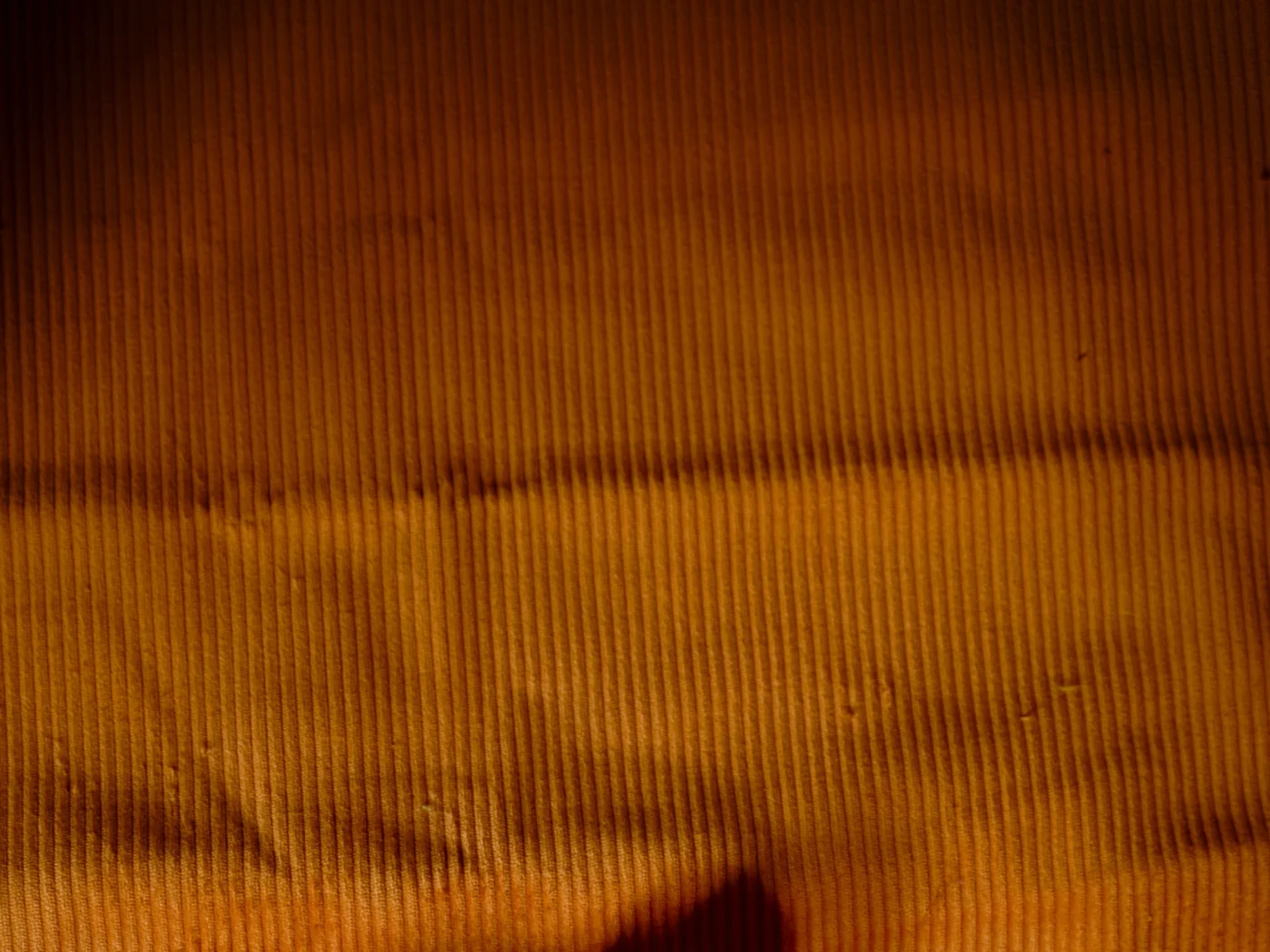
Corduroy’s unique blend of texture, durability, and comfort makes it a fabric that stands out in fashion, offering both a practical and stylish option for a wide range of garments, from jackets to trousers. Whether used for everyday wear or as a luxury item, corduroy remains a beloved fabric with a rich history and lasting appeal
Corduroy Fabric Composition
Corduroy fabric is primarily composed of cotton, but it can also be made from a variety of other fibers, either on their own or blended with cotton. The choice of material affects the texture, durability, and overall feel of the fabric, making the composition a key factor in its versatility and appeal.
- Cotton Corduroy:
Cotton is the most common fiber used in corduroy, offering softness, breathability, and comfort. It’s also a natural fiber, making it more eco-friendly compared to synthetic alternatives. Cotton corduroy has a smooth, soft feel and a warm, cozy quality, making it ideal for cooler weather clothing like jackets, pants, and skirts. The fabric’s ability to wick moisture away from the skin also makes it a good option for casual wear. - Blended Corduroy (Cotton-Polyester):
To enhance durability and reduce wrinkling, corduroy is often blended with polyester or other synthetic fibers. Polyester blends increase the fabric’s resilience, making it more resistant to wear and tear. These blends are also less prone to fading and shrinking, which can be an issue with pure cotton corduroy. Polyester corduroy is typically used in everyday clothing and accessories, where durability and easy care are important. - Wool Corduroy:
For colder climates, wool can be blended with corduroy to provide extra warmth. Wool corduroy is a luxurious and insulating fabric, ideal for outerwear like coats and jackets. Wool fibers add a soft, plush feel to the fabric while also improving its ability to trap heat, making it a great choice for winter clothing. - Spandex and Other Stretch Fabrics:
In modern designs, corduroy is sometimes blended with spandex or elastane to create a fabric with some stretch. This blend adds flexibility and comfort, allowing for better mobility, which is particularly useful in garments like skinny jeans or pants. Stretch corduroy combines the fabric’s classic texture with the comfort of stretch materials, making it a more practical choice for activewear.
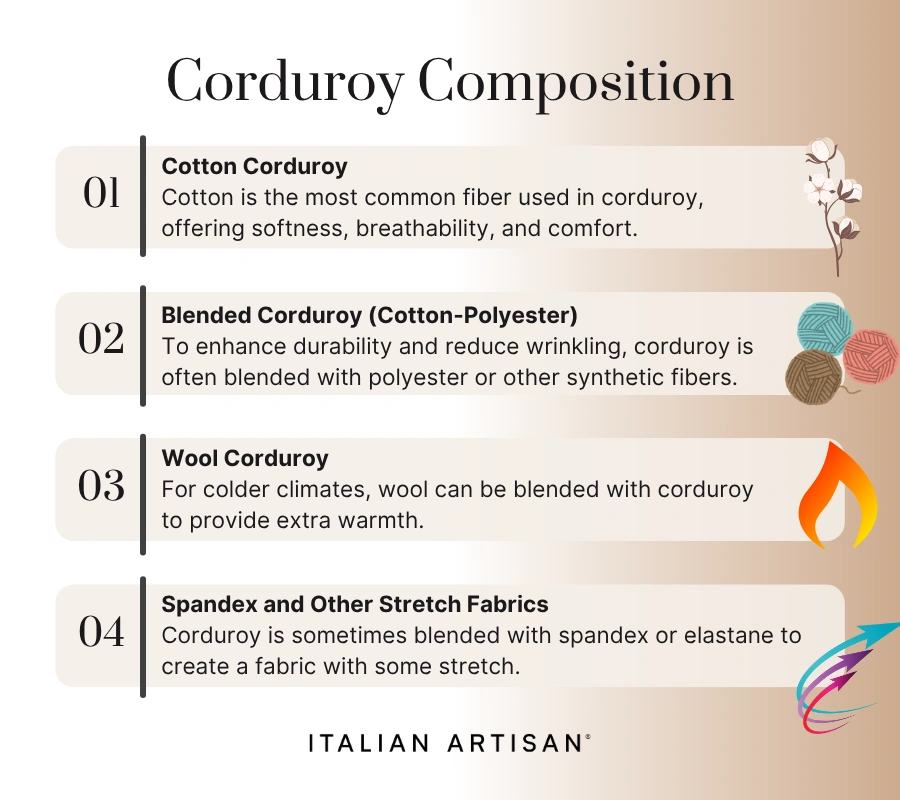
The composition of corduroy fabric determines its weight, texture, and suitability for different types of clothing. Whether made from pure cotton for softness and breathability or blended with synthetic fibers for added durability, corduroy offers a wide range of options for creating comfortable, long-lasting garments. Understanding the composition helps consumers select the right type of corduroy based on their needs, whether they prioritize comfort, durability, or warmth.
Corduroy Fabric V.S Other Fabrics
Corduroy stands out for its unique ridged texture, but it shares some similarities with other fabrics like velvet, denim, and tweed. Here’s how it compares:
- Corduroy vs Velvet:
- Velvet has a smooth, glossy surface, while corduroy’s ridges create a matte, textured look. Velvet is more delicate and used for formal wear, while corduroy is more durable and casual.
- Corduroy vs Denim:
- Denim is heavier and smoother, whereas corduroy is lighter and softer. Corduroy is more comfortable and flexible, making it better for everyday wear, while denim can feel stiff and restrictive.
- Corduroy vs Corded Fabrics:
- Both feature raised ridges, but corded fabrics have a less pronounced pattern. Corduroy’s thicker, more tactile texture offers greater warmth and durability, making it suitable for a wider range of garments.
- Corduroy vs Tweed:
- Tweed is heavier and often used for outerwear, while corduroy is lighter and more flexible, ideal for casual clothing. Corduroy is better for transitional seasons, while tweed is used for colder weather.
Corduroy’s combination of texture, durability, and comfort makes it a versatile fabric, standing out in casual and transitional fashion.
How Corduroy Fabric Is Manufactured
Corduroy fabric is produced through a specialized weaving process that creates its signature ridged texture, or “wale.” The manufacturing techniques used can vary, but they all aim to achieve the fabric’s unique texture and durability. Here’s how corduroy is typically made:
- Weaving Process:
Corduroy is made using a cut-pile weave, where extra threads are woven into the fabric to form raised ridges. These fibers are then cut and brushed, creating the distinctive ridged pattern. The spacing between these ridges, known as the “wale,” can vary, affecting the fabric’s feel and weight. - Types of Wale:
The wale refers to the number of ridges per inch of fabric. Fine wale corduroy has narrow ridges and is softer and lighter, while wide wale corduroy has thicker, more pronounced ridges and is heavier and more durable. - Fiber Composition:
Traditionally made from cotton, corduroy can also be made from a blend of fibers like polyester, wool, or even elastane. Cotton corduroy is soft and breathable, while polyester blends improve durability and wrinkle resistance. Wool corduroy adds warmth, and spandex blends allow for stretch and comfort. - Finishing Touches:
After weaving, corduroy fabric is often brushed to further emphasize the texture of the ridges and enhance its softness. The fabric can be dyed in various colors, and additional finishes like water resistance or softness can be added depending on the intended use.
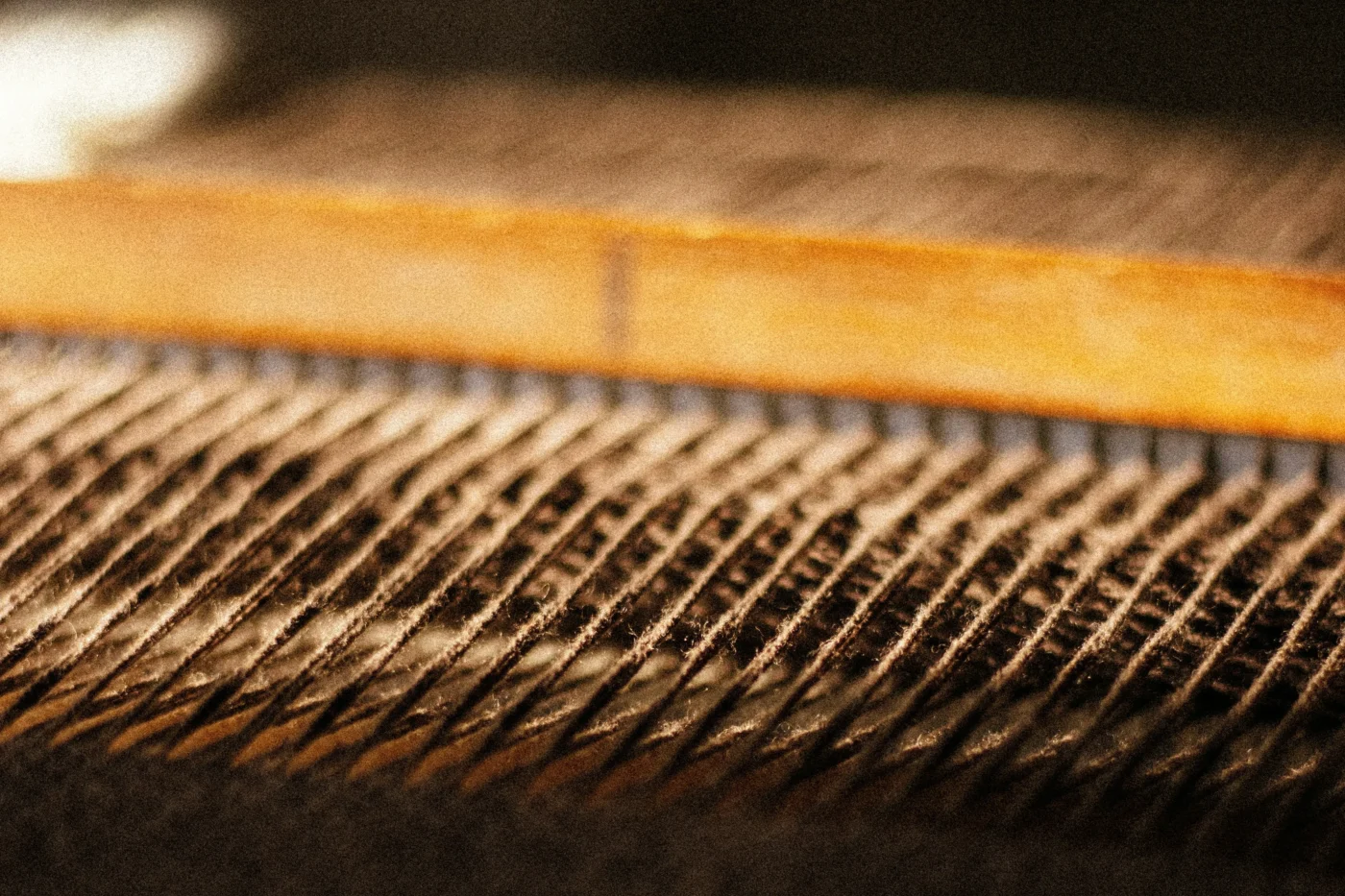
The manufacturing process gives corduroy its unique tactile quality, allowing for a variety of weights and textures. Whether made from cotton, wool, or synthetic fibers, the fabric’s versatility makes it suitable for many fashion and home décor applications.
Produce your fashion collection with us
Common Uses in Fashion
Corduroy fabric is known for its durability and distinctive texture, making it a versatile choice for various fashion applications. Its comfortable yet sturdy nature allows it to be used in both casual and more structured designs. Here are some common uses of corduroy in fashion:
- Pants and Trousers:
Corduroy is most commonly used in pants and trousers. Its soft texture and durability make it ideal for everyday wear, offering warmth and comfort without the heaviness of denim. - Jackets and Blazers:
Corduroy jackets and blazers provide a stylish, textured alternative to traditional fabrics. They are popular for both casual and semi-formal settings, offering a classic yet comfortable look. - Skirts and Dresses:
Corduroy is often used in skirts and dresses, especially during the cooler months. Its thickness makes it suitable for autumn and winter, offering both warmth and a stylish appearance. - Shirts and Tops:
Corduroy shirts, particularly those with a fine wale, are a great option for adding texture to casual outfits. The fabric is soft yet durable, making it ideal for shirts that need to hold up to regular wear. - Accessories:
Corduroy is also used in accessories like hats, bags, and scarves. Its durability and texture make it an attractive material for these items, adding a touch of style to everyday accessories. - Kidswear:
Due to its soft texture and sturdy construction, corduroy is a popular choice for children’s clothing. It provides comfort and resilience, making it ideal for active young ones.
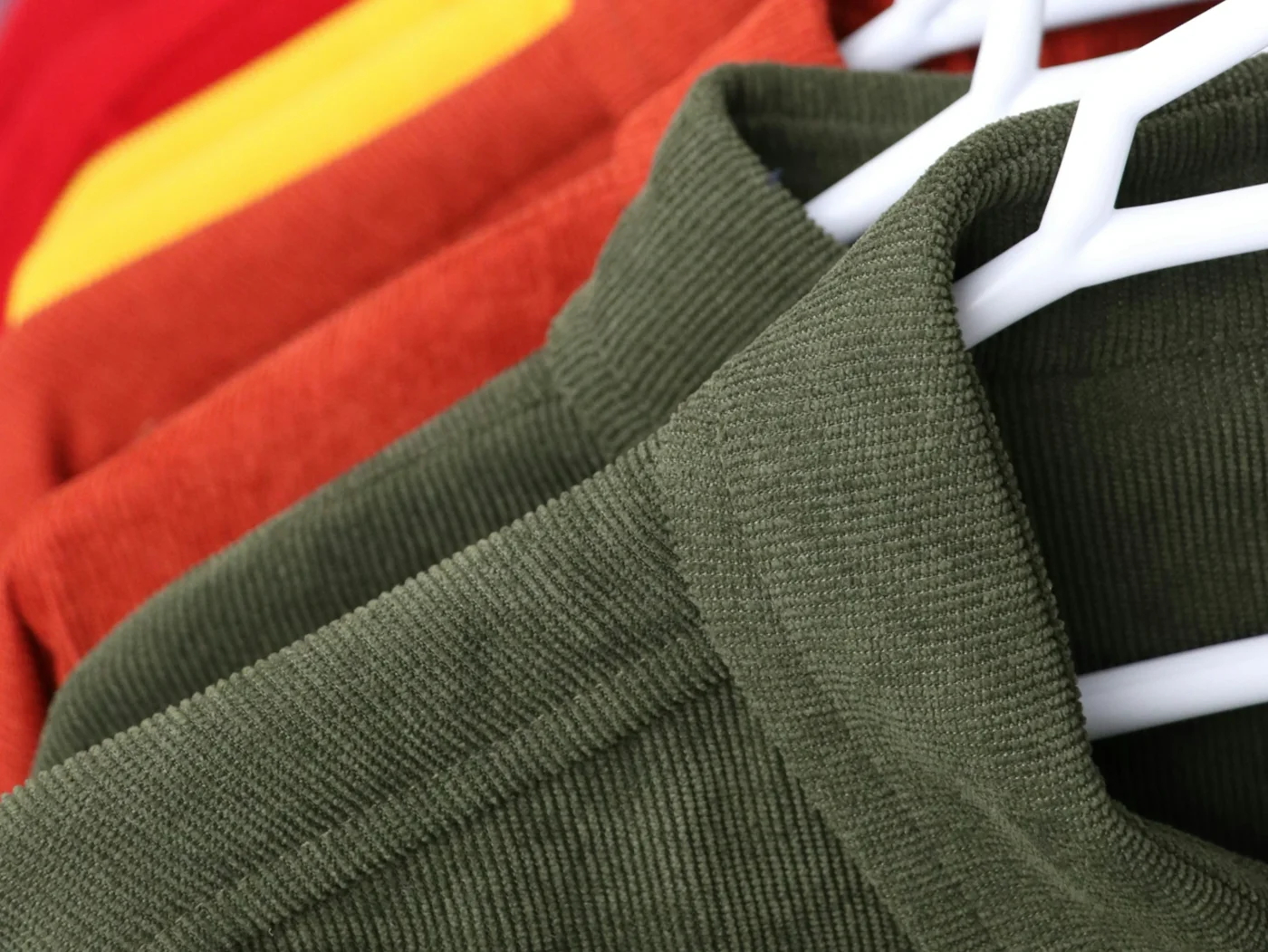
Corduroy’s unique look, comfort, and versatility make it a favorite fabric across a range of garments and accessories, from casual pants to stylish jackets and trendy kids-wear.
Understanding the Environmental Impact of Corduroy Fabric
Like many fabrics, corduroy has an environmental footprint that depends on its material composition and manufacturing processes. Understanding this impact can help consumers make more sustainable choices when selecting fabrics for their wardrobe. Here’s a breakdown of how corduroy affects the environment:
- Material Sourcing:
- Natural fibers like cotton, commonly used for corduroy, require significant water and pesticide use in conventional farming. However, organic cotton offers a more sustainable alternative as it is grown without harmful chemicals and uses less water.
- Synthetic fibers like polyester, often blended with cotton in corduroy, are made from petroleum-based resources, contributing to resource depletion and environmental pollution. Polyester is not biodegradable and can take hundreds of years to break down in landfills.
- Manufacturing Process:
- Corduroy fabric is produced using energy-intensive methods, particularly in machine-made varieties. The weaving process and the use of synthetic fibers can increase the carbon footprint of the fabric.
- The dyeing process used to color corduroy fabrics often requires water and chemicals, which can lead to water pollution if not managed properly.
- Sustainable Alternatives:
- Organic Cotton Corduroy: Made from cotton grown without harmful chemicals, organic corduroy is a more environmentally friendly option.
- Recycled Materials: Some corduroy fabrics are made from recycled polyester or other fibers, helping reduce waste and the need for new resources.
- Eco-friendly Dyeing Techniques: Brands are increasingly using waterless dyeing methods and non-toxic dyes to minimize the environmental impact of the production process.
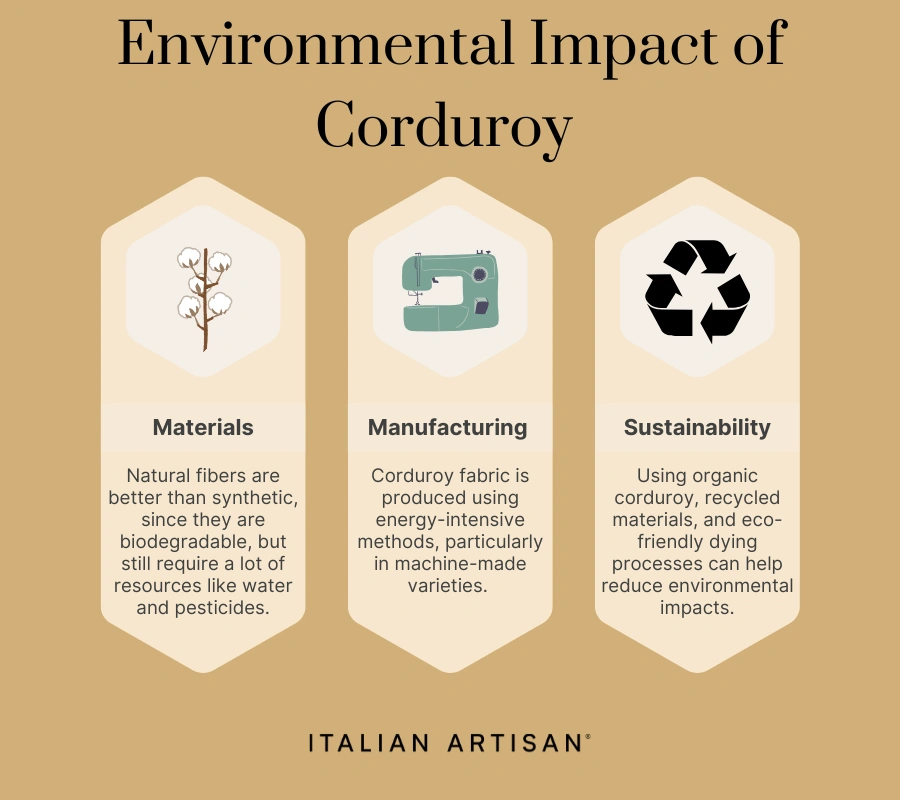
By opting for sustainable alternatives like organic cotton or recycled fibers, the environmental impact of corduroy can be reduced. Consumers and designers can play a role in supporting more eco-friendly practices by choosing fabrics that prioritize sustainability and minimize harm to the environment.
Exploring Price Points and Value for Money
Corduroy fabric comes in various price ranges, influenced by the material, manufacturing process, and design complexity:
- Material:
- Cotton corduroy is generally affordable, while blended corduroy (e.g., cotton and polyester) is even cheaper.
- Wool corduroy is higher-end and more expensive due to its luxurious qualities.
- Manufacturing Method:
- Machine-made corduroy is cost-effective for mass production, whereas handmade corduroy or custom designs are pricier due to the time and craftsmanship involved.
- Design Complexity:
- Simple corduroy fabrics are more affordable, while those with intricate patterns or embellishments cost more.
- Value for Money:
- Corduroy is durable and versatile, making it a good investment for everyday wear. The fabric’s longevity adds value, especially compared to other materials like denim.
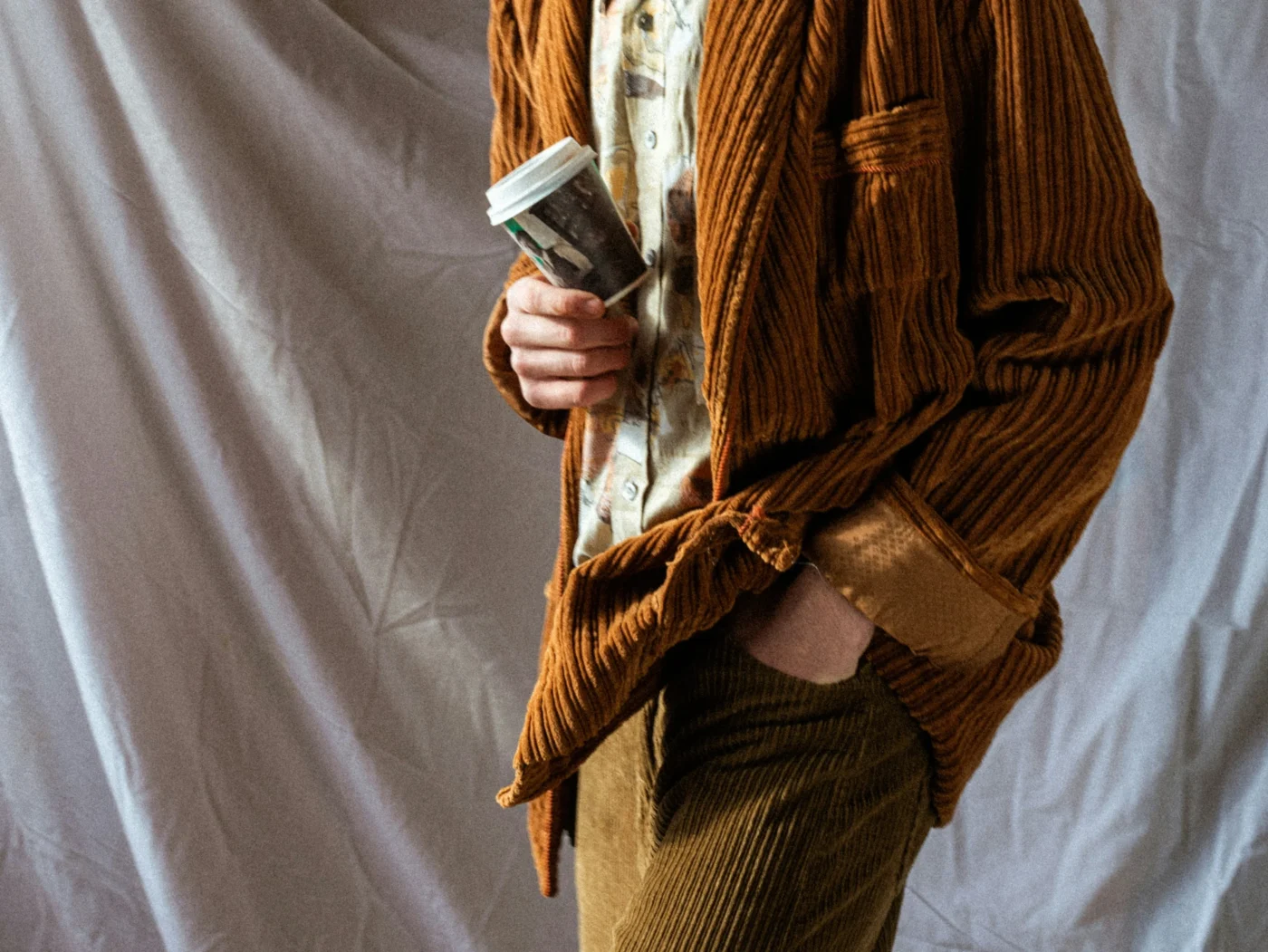
Corduroy offers a range of prices, ensuring there is an option for any budget, with excellent value in terms of durability and timeless style.
Conclusion
Corduroy is a versatile and durable fabric with a unique ridged texture, making it a popular choice for a variety of garments, from casual pants to jackets. Its rich history, sustainable alternatives, and adaptability through seasons ensure its enduring appeal. While corduroy’s price varies based on material and production method, its longevity and timeless style offer great value. As demand for eco-friendly fabrics grows, corduroy made from organic cotton or recycled fibers is becoming a more sustainable option, maintaining both quality and style.
FAQs
- What is corduroy fabric made of?
Corduroy is primarily made from cotton, but can also be blended with synthetic fibers like polyester or natural fibers like wool for added durability, warmth, or flexibility. - How do I care for corduroy fabric?
Corduroy should be gently washed in cold water to avoid damaging the fabric’s texture. Dry cleaning is also recommended for delicate blends. Always avoid high heat to maintain its softness and shape. - What are the different types of corduroy?
Corduroy comes in various wales—fine wale (narrow ridges) for softer, lighter fabric, and wide wale (thicker ridges) for heavier, more durable fabric. - Is corduroy fabric durable?
Yes, corduroy is a durable fabric, especially when made with cotton or blended fibers. It is ideal for everyday wear, as it resists wear and tear better than smoother fabrics. - Can corduroy be used for formal wear?
Yes, corduroy can be used in both casual and semi-formal settings. It is commonly used in jackets, blazers, and trousers for a textured, sophisticated look. - Is corduroy suitable for all seasons?
Corduroy is typically worn in cooler weather due to its warmth, but lighter, finer wale corduroy can also be used in transitional seasons like spring and fall. - Can I use corduroy for children’s clothing?
Yes, corduroy is a popular choice for children’s clothing due to its softness, durability, and comfort, making it perfect for active wear. - Is corduroy environmentally friendly?
Corduroy made from organic cotton or recycled fibers is a more sustainable option, reducing the environmental impact compared to traditional cotton or polyester corduroy. - How can I style corduroy in my wardrobe?
Corduroy can be styled in casual outfits like jeans and jackets or used in more formal attire such as blazers. It pairs well with simple, natural fabrics like cotton and wool. - Is corduroy expensive?
The cost of corduroy varies depending on the material and manufacturing process, but it is generally affordable, with premium blends like wool corduroy being more expensive.




